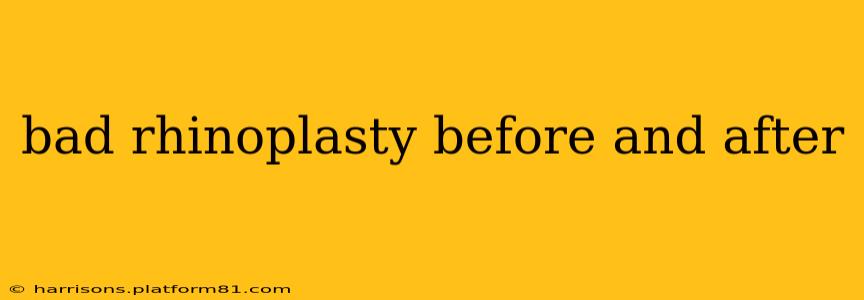Rhinoplasty, or a nose job, is one of the most popular cosmetic surgeries worldwide. While many patients achieve their desired results and are thrilled with their improved appearance, some unfortunately experience less-than-ideal outcomes. This article explores the reasons behind a "bad" rhinoplasty, examining before and after photos, discussing revision surgery options, and offering preventative measures. We will address common concerns and provide helpful insights for anyone considering this procedure.
What Constitutes a "Bad" Rhinoplasty?
Defining a "bad" rhinoplasty is subjective. What one person considers unsatisfactory, another might find acceptable. However, several common issues indicate a less-than-successful outcome:
- Asymmetry: A noticeable imbalance between the two sides of the nose, affecting the tip, bridge, or overall shape.
- Poor Tip Definition: A drooping, bulbous, or excessively pointed tip that doesn't complement the rest of the facial features.
- Breathing Difficulties: Post-surgical breathing problems, including nasal obstruction or difficulty breathing through the nose. This is a serious complication and requires immediate medical attention.
- Over- or Under-Correction: The nose may be too small, too large, or drastically different from the patient's initial expectations and natural facial harmony.
- Visible Scars: Prominent scars around the nostrils or on the columella (the fleshy part between the nostrils).
- Unsatisfactory Profile: The nose's profile doesn't look natural or aesthetically pleasing in relation to the face.
- Skin Issues: Problems such as skin irregularities, excessive swelling, or skin necrosis (tissue death).
Before and After Photos: What to Look For
Before and after photos are crucial when researching rhinoplasty. However, remember that individual results vary significantly. Look for:
- Natural-Looking Results: The nose should look proportionate to the rest of the face and appear natural, not overly operated on.
- Improved Symmetry: Notice if any asymmetry has been corrected successfully, creating a balanced appearance.
- Improved Breathing: If breathing difficulties were a concern pre-surgery, look for evidence that the issue has been resolved (although photos alone won't confirm this).
- Consistency with Patient's Goals: The results should match the patient's desired outcome, as relayed in the consultation.
How Can I Avoid a Bad Rhinoplasty?
Choosing the right surgeon is the most crucial step in preventing a negative outcome.
- Thorough Research: Investigate the surgeon's qualifications, experience, board certification, and before-and-after photos. Seek out surgeons specializing in rhinoplasty.
- Detailed Consultation: Have a thorough consultation to discuss your goals, expectations, and any potential risks. A good surgeon will manage expectations realistically.
- Realistic Expectations: Understand that perfect results are not guaranteed, and some degree of swelling and bruising is normal.
- Second Opinions: Don't hesitate to seek second opinions from other qualified surgeons.
- Clear Communication: Maintain open and honest communication with your surgeon throughout the process.
What if My Rhinoplasty Went Wrong? Revision Rhinoplasty
If you're unhappy with the results of your rhinoplasty, a revision rhinoplasty may be an option. This procedure is more complex than an initial rhinoplasty and requires a highly experienced and skilled surgeon. Revision surgery aims to correct the imperfections of the previous procedure. However, it's crucial to understand that there are limitations, and complete correction isn't always possible.
Can a Bad Rhinoplasty Be Fixed Completely?
While revision rhinoplasty can significantly improve unsatisfactory results, complete correction isn't always possible. The complexity of the nose's structure and the limitations of the surgical techniques mean that some imperfections might persist.
What are the Risks Associated with Rhinoplasty?
Rhinoplasty, like any surgical procedure, carries potential risks, including:
- Infection: The risk of infection is relatively low but can lead to serious complications if it occurs.
- Bleeding: Excessive bleeding is a potential complication, requiring immediate medical attention.
- Swelling: Significant swelling is expected after surgery, but it should gradually subside.
- Numbness: Temporary or permanent numbness in the nose or surrounding areas can occur.
- Changes in Sense of Smell: Alterations to the sense of smell are a potential risk.
- Breathing Problems: Difficulty breathing through the nose can occur and may necessitate further surgical intervention.
This information is intended for educational purposes only and should not be considered medical advice. Always consult a qualified medical professional for any health concerns or before making any decisions related to your health or treatment. The experience of a "bad" rhinoplasty can be distressing; understanding the factors involved and seeking the appropriate medical help is crucial for achieving a satisfying outcome.
